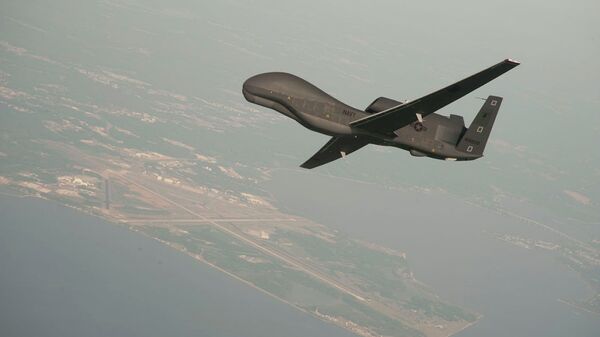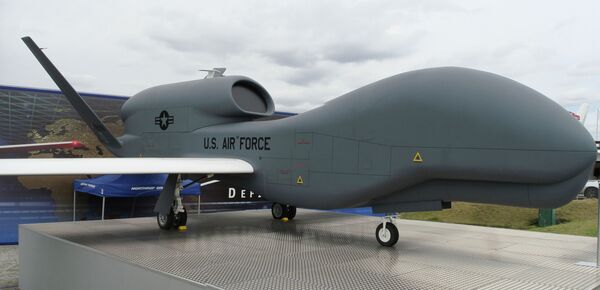According to the reports, the drone – a US Air Force RQ-4 Global Hawk, took off from the Sigonella air base in Sicily, Italy on Saturday, flying toward Crimea from the west at a height of 15,500 meters. After that, the drone entered Ukrainian airspace along the water in Mykolayiv region, and continued its flight east of Kherson to Melitopol, carrying out reconnaissance north of the Crimean peninsula.
Since January 2015, US drones have carried out regular airborne reconnaissance in areas around Russia in the Black Sea.
Asked to comment about the drone's likely mission, veteran military analyst Konstantin Sivkov told the independent online newspaper Svobodnaya Pressa that it's sufficient to consider the RQ-4 Global Hawk's advanced capabilities, which include photographic and electronic reconnaissance.
"If the drone was really flying along this route, the photographic reconnaissance component drops out, and electronic reconnaissance, meant to find the location, operating conditions and emission characteristics of radar air defense systems is highly likely to have taken place," the analyst explained.
For his part, military historian Alexander Shirokorad recalled that US P-8A Poseidon ASW patrol aircraft, also stationed at Sigonella, have made regular flights near Crimea, as well as Russian bases in Syria, in recent weeks and months. "In September, their flights were associated with the Kavkaz-2016 strategic command staff exercises. The US military was looking to ascertain the workings of our forces command and control, and the intelligence and radio engineering capabilities possessed by the Russian Navy."
As far as reconnaissance in the Donbass is concerned, Shirokorad stressed that in accordance with the Minsk peace agreements, the flight of any aircraft in an area 30 km along the demarcation line from either direction is prohibited. "Therefore, the US would not risk flying close" to the area.
There are several reasons for this. "First, the drone's radio reconnaissance capabilities allow it to explore beyond the 217 km" distance that it flew from the front line. "Second, the international legal situation as far as drones are concerned has not been fully resolved, and if something suddenly happens, proving the offender would be virtually impossible. Obviously, it's difficult to handle these heavy-class devices, controlled via highly encrypted satellite communications, and almost impossible to intercept. It would be easier to break the link with the satellite," which would activate the system's inertial navigation system, thus forcing it to return to base.
The expert suggested that it's entirely possible that the Global Hawk's flight may have been connected to the testing of new equipment. The drone's developer, Northrop Grumman, has recently been engaged in testing of an RQ-4 with an optical high resolution camera of the kind normally fitted on U-2 aircraft, along with testing of the Syers-2 multispectral electro-optical camera. It's possible, Shirokorad noted, that the US military may have decided to test these new tools in real world conditions in an important region.
"Such a decision was ultimately adopted. The budget of US European Command was increased significantly. Some of that money was undoubtedly spent on strengthening NATO structures, but a large part was also committed to intelligence-gathering. And that's what we are now seeing – the number of flights by reconnaissance aircraft has increased. The Pentagon is actively monitoring where certain units are stationed in Crimea and southern Russia, as well as the disposition of DPR and LPR militia in southeast Ukraine."
Ermakov noted that while he could not rule out the possibility that the US is handing some of its collected information over to Ukraine, "one gets the impression that they are working for themselves, looking to use the collected data strictly to their advantage. For example, to draw us in to new negotiations on 'risk reduction and military transparency', etc. For us, the main thing is that they do not provoke Ukraine into any sort of [military] action," the analyst stressed.
Finally, Andrei Frolov, editor-in-chief of the military magazine Arms Export, told the online newspaper that doubts have been expressed about the veracity of media reports regarding the flight. In any case, he noted that the US already has many other intelligence gathering systems which them to monitor the situation in Crimea and southeast Ukraine, including reconnaissance satellites, ground-based signals intelligence stations, and the associated technologies for carrying this equipment on Navy ships in the Black Sea.
"From the strategic perspective, using a drone for reconnaissance on the location of DPR and LPR units is overkill….Such a flight would be justified only in one case – if the US very needed to know something urgently, because otherwise satellite intelligence flies over the area every day."







